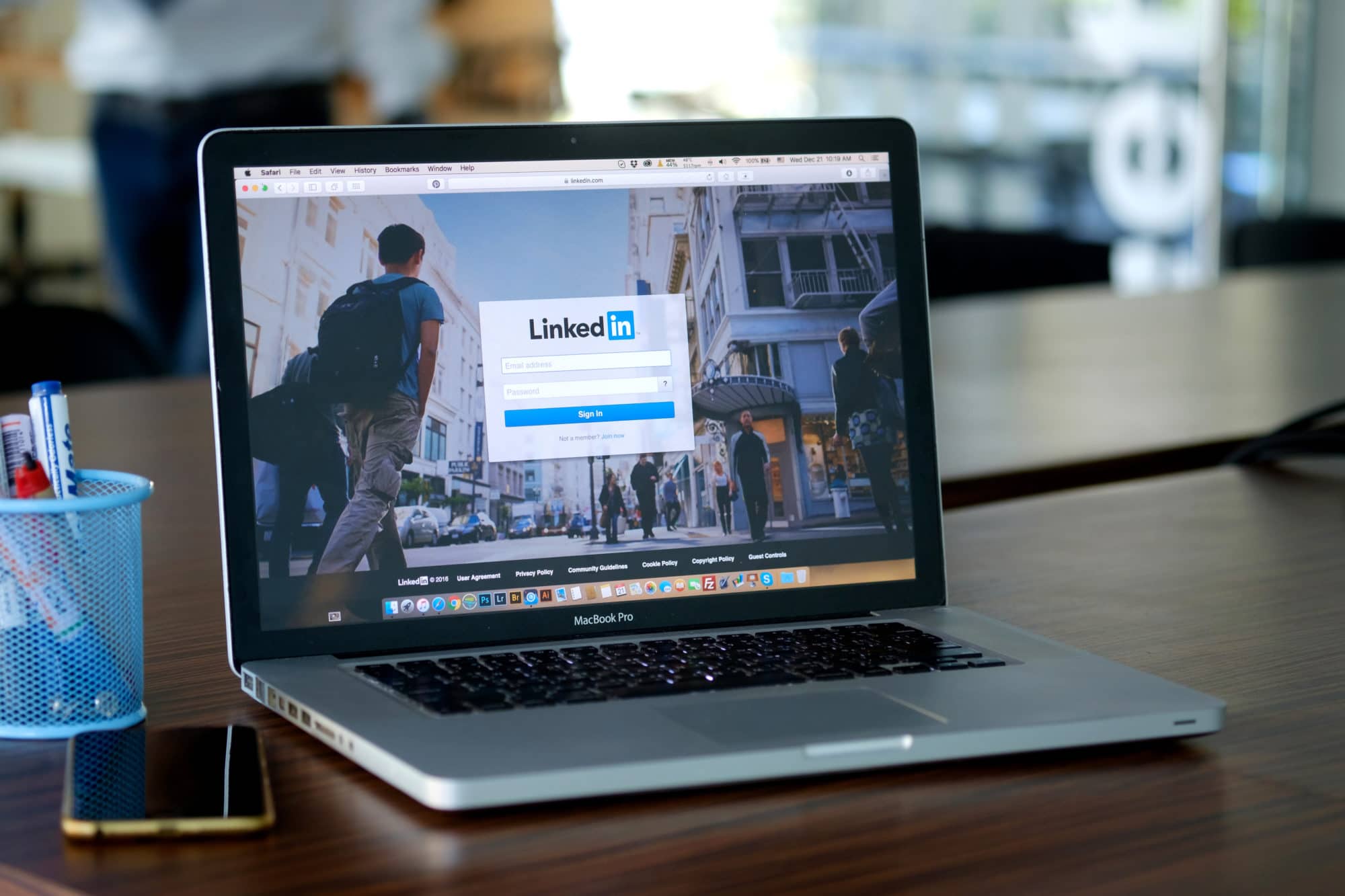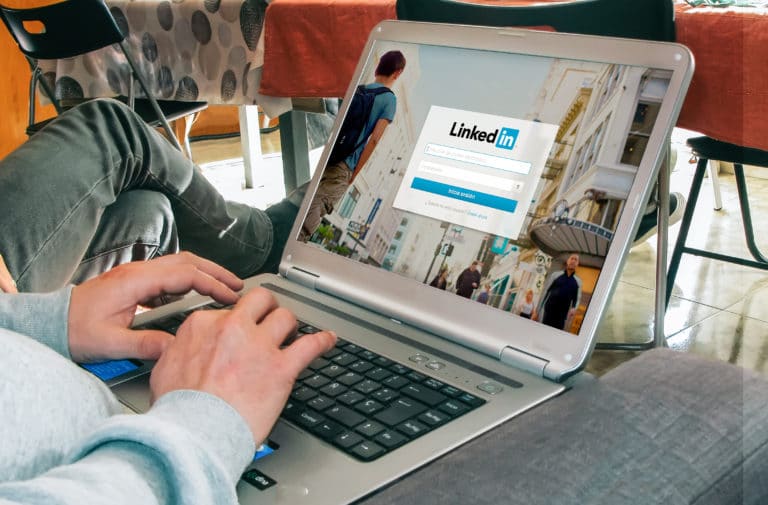This post was updated in June 2025 to reflect new changes to the LinkedIn algorithm.
It can be frustrating trying to grow your business or territory on LinkedIn, not knowing why your posts aren’t getting much engagement or why you’re not building pipeline from your messaging and content creation efforts.
After all, that’s why we use this platform, right? – to build revenue!
This post will walk you through these LinkedIn algorithm changes in layman’s terms. We hope it will help you know what you should be doing differently to ensure your target audience sees and engages with your content.
Why is this important?
LinkedIn is an 810 million-strong social media platform whose main demographic influences B2B buying decisions.
It’s a gold mine for attracting and reaching your target audience.
What Is the LinkedIn Algorithm & Why Do We Care?
Like most social media platforms, LinkedIn has an algorithm that determines the posts people see in their feed. The algorithm is designed to help ensure users get the best experience on the platform by promoting relevant and valuable content.
As a marketer, understanding the LinkedIn algorithm in 2025 is crucial as it will help you design an effective social selling strategy.
So, what is the LinkedIn algorithm?
Simply put, an algorithm is used to turn large amounts of data into a model. We care about this because what each algorithm is “taught” affects us every day, and most of the time, you don’t even know it. With LinkedIn doubling down on the way users interact with their platform, they’re constantly updating their algorithms to ensure the most engaging users get the most out of the platform.
Every time you’re sipping on your morning cup-o-joe and open up LinkedIn, you make a subconscious, split-second decision to either a) yes, read this extremely relevant article at the top of my feed, or b) the opposite, and scroll right past.
That split-second decision was you playing a role in teaching the new LinkedIn Algorithm how better to serve you and every other professional like you.
How the LinkedIn Algorithm Works
The LinkedIn algorithm goes through several steps to rank and promote your post in users’ feeds. Here’s a simple walkthrough of how it does it:
Step 1: Qualify Content
The first step that your post goes through is the qualification process. This is where the algorithm places content into three different buckets:
- Spam
- Low quality
- High-quality
Your goal is to get your content in the high-quality bucket. This way, it gets shown to a larger audience.
Step 2: Testing Stage
After filtering your content through the three filters above, your post is sent to a small portion of your audience. This is so the algorithm can test how well they’ll receive it. If it garners good engagement, it gets shown to your broader audience.
Step 3: Scoring
Once your users start engaging with your post, the LinkedIn algorithm starts scoring it according to the type of engagement it gets. Each engagement type (like share, comment) carries a different score. Posts with high scores get shown to more people, while those that don’t score well get demoted.
Step 4: Verification by Human Editors
The last step of the algorithm involves human editors who go through posts that have been receiving excellent engagement. These use LinkedIn’s standards to determine whether the content should be:
- Promoted to people out of your network
- Keep it within your network
- Demote it depending on the nature of the content
If your content reaches this stage, the chances of it gaining more traction are multiplied.
Breaking It Down
Suppose you’re scrolling through LinkedIn, and you stop to read a post.
If you decide to leave a comment after you read the post, you have just given that post Creator Love. It’s actually called that.
Maybe you liked the post so much that you reshared it, creating a downstream Viral Effect.
What’s important to remember is even if you didn’t take action at all, the time you spent to decide whether or not you were going to is what the LinkedIn Engineers are fondly referring to as Dwell Time. But more on that in a moment.
LinkedIn heavily considers these three pieces of information to present users with the most relevant content for their specific needs.
How Did the Previous Algorithm Work?
Alright, so we understand what an algorithm is and how we constantly help it learn. We’ve also covered some important LinkedIn Engineering lingo. So, let’s piece it all together. Prior to the algorithm change, what you saw on your newsfeed was strictly based on viral actions, creator love and the probability of upstream and downstream effects. It was geared towards the idea of “getting small content creators to create more content.”

This model was slightly flawed because it focused on predicting a post’s virality and/or clickability vs. if the post was worthy of reading.
Understanding all this will help you leverage the LinkedIn algorithm to your advantage, thereby increasing the chances of your target audience seeing your content.
So, what are the LinkedIn Algorithm best practices you should follow in 2025?
LinkedIn Algorithm 2025: Tips for Increasing Your Visibility and Engagement
Many marketers make the mistake of trying to game the LinkedIn algorithm. All that does is give you short-term wins. To win at growing your brand and business on LinkedIn, you need a sustainable solution. You need to work with the algorithm, not against it. Here are a few LinkedIn algorithm best practices to help you do just that:
Factor in Dwell Time
Dwell time is one of the algorithm factors LinkedIn uses to know which content to promote to users. Dwell time is the amount of time spent looking at an update after half the post is visible on the screen. One of the reasons it was introduced was to rectify one major flaw of the previous algorithm — rewarding those who may receive viral actions (such as mindless likes.)
Take this recent post by Daymond John, the CEO of FUBU and Shark from Shark Tank. Great person, don’t get me wrong, but not an extremely valuable post. I would most likely click like and keep scrolling, only because 4,302 other people already had.
The Dwell Time variable inherently stops this from being at the top of your feed every time you sit down for coffee and makes it more likely to see a relevant post rather than a viral one. Because there’s not much to read here, and since you’re just barreling through it, it will not get rewarded.
Creator Love: Why Posting Regularly is Crucial for Engagement
Posting on LinkedIn frequently is not only good practice. It’s essential to stay top of mind and, frankly, top of the news feed. As we’ve previously explored, LinkedIn focuses heavily on the professional community and rewards those that contribute to it organically.
Let’s explore a few scenarios:
Scenario #1
John is posting two times a month, which he has scheduled on Mondays with his Lunch break at 11 am. He has noticed a lack of engagement on these posts, regardless of how well-written and thought-out they are.
Scenario #2
Sally is posting 4-5 times a month at varying days and times throughout the week. Her content is well-thought-out and stays on top of trends and topics. She notices an uptick in engagement and requests to connect. There are more discussions on her posts, allowing her to use social selling techniques to reach out to those who engaged.
So, What Happened Here?
Creator Love happened! LinkedIn rewards Sally for being a naturally contributing member of the LinkedIn Community. Her posts surface on others’ newsfeeds, while Johns simply get lost because of the frequency and timing. Based on our research, LinkedIn rewards users that post at least once a week. However, once a day is recommended to reach 60% of your audience and for better engagement. This means anything from 5-20 times a month can get you good results. On the other hand, if you’re only posting twice a month, consider splitting your longer posts into four to maximize engagement potential.
It’s more than just likes. You’ve spent time researching and writing, and it deserves to be seen.
Best Practices for Posting Frequency
- Post 20 times per month at varying times between Tuesday-Thursday
- Keep these posts on topic and on-trend
- Respond to comments!
Be sure to interact with others’ posts as well!
Cap Connection Requests
People often ask us if we’ve discovered the perfect number of outbound LinkedIn requests to send each day.
LinkedIn caps each user’s connection requests to a certain limit per day. For others, they can’t send more than 100 connection requests per week (20/workday). Others, however, can send 200 or 300 connection requests per week – across the board. But your actual limit isn’t known to you or published. It’s based on a black-box algorithm LinkedIn built.
If you send over that limit, LinkedIn will show you an error message, asking you to only connect with people you know. It will also tell you that you hit your limit for the week. In rare cases, you may potentially be required to add an email address each time you connect with someone new.
Why is this important?
One thing LinkedIn is trying to do is reduce the activity of bots on the platform. But unfortunately, while you can use automation tools to grow your brand on the platform, LinkedIn frowns on automation — unless you use their Sales Navigator tool.
Sending too many connection requests can get you flagged as a bot, resulting in your content not being shown to many people. In the worst-case scenario, you could end up in LinkedIn jail.
Post at the Right Time
Another element of the LinkedIn algorithm you must know is that timing is everything.
Why?
Remember, the algorithm promotes content that users engage with the most.
For example, if you post when most of your audience is offline, your post will have terrible engagement in the first couple of hours (the golden window). These first few hours are essential as they determine how wide of an audience LinkedIn will promote your content to.
On the other hand, if you post when most of your audience is online, your post will have better engagement during the golden window. As a result, the algorithm will promote it to more people.
So, what are the best times to post on LinkedIn?
Unfortunately, the answer to this is not straightforward. That’s because so many factors impact the best time to post. Some of the most common ones include:
- Your audience demographics. Particularly geographic location, as this determines when most of your audience will be active.
- Audience’s daily habits. Daily habits such as when people log in to LinkedIn can also determine when you should post. With LinkedIn being a professional network, expect most engagement during work hours.
The best way to know when to post is to conduct thorough testing that involves posting content at different times on different days. This will help you determine when your audience is most engaged, resulting in a more effective LinkedIn marketing campaign.
Create Content the LinkedIn Algorithm Loves
Another critical factor to consider when trying to leverage the LinkedIn algorithm is that it promotes certain types of content.
Remember, LinkedIn is a professional platform. Because of this, content that may perform well on other social media platforms like Facebook, Instagram, e.t.c., will tank on LinkedIn. The LinkedIn algorithm doesn’t care much for memes, GIFs, cat pics or videos. Instead, the platform prefers to show users professional content. Examples include:
- Industry news
- Job posts
- Business or career tips and advice
It’s also important to note that the LinkedIn algorithm favors text-based content over visual content. However, your engagement rates will improve if you use relevant visuals that resonate with your audience. Of course, this leads to your content being shown to a wider audience.
When it comes to winning on LinkedIn, quality content should be at the core of your strategy. A well-executed LinkedIn content marketing strategy will help set you up as a sought-after LinkedIn thought leader.
Post Regularly
Because LinkedIn favors engagement, one factor that the algorithm uses to promote content is how frequently you post content. Naturally, users who post more regularly tend to have their content ranked higher and displayed to more people than those who are sporadic in the way they post.
Besides posting regularly, LinkedIn also watches how you engage on the platform. This includes how you interact with other users, the time you spend on the platform and much more. They value engaged users and thus ensure that their content gets viewed by their target audience.
Polish Up Your Profile and Update it Regularly
LinkedIn scans your profile, especially when the algorithm is trying to evaluate your content. You must invest in crafting an optimized profile that reflects who you are and why you’re a trusted authority in your field.
You should also try to keep your profile updated as you add new skills, change jobs, experience, achievements, e.t.c. One thing for this is that the LinkedIn algorithm loves active accounts. It also helps you separate yourself from the bots.
You should also update recommendations and endorsements as they add more clout to your profile.
So What Should You Do Now?
The best advice we have for you is to continue to create great, meaningful content that people spend time reading. Avoid creating clickbait-style posts as you’re now being penalized. Other than that, there’s not much else you should change about your workflow if you’ve been following those two notions!
At first glance, this graph looks like job postings, videos, and articles are going to be the death of your company’s content on LinkedIn. It also looks like images steadily perform the best. This isn’t totally true!
What this graph actually shows is an introduction of a new metric called Tskip. Tskip is simply a threshold marker for posts that are viewed for less than a certain amount of time and, therefore, not particularly engaging. So what happens after Tskip or the green vertical dashed line on the graph actually has nothing to do with the new LinkedIn Algorithm.
As you can see in the infographic below, the magnifying glass highlights the three colored lines, which are almost identical in all six graphs above. This indicates that the time for skipping an update, regardless of the time, is almost equivalent.
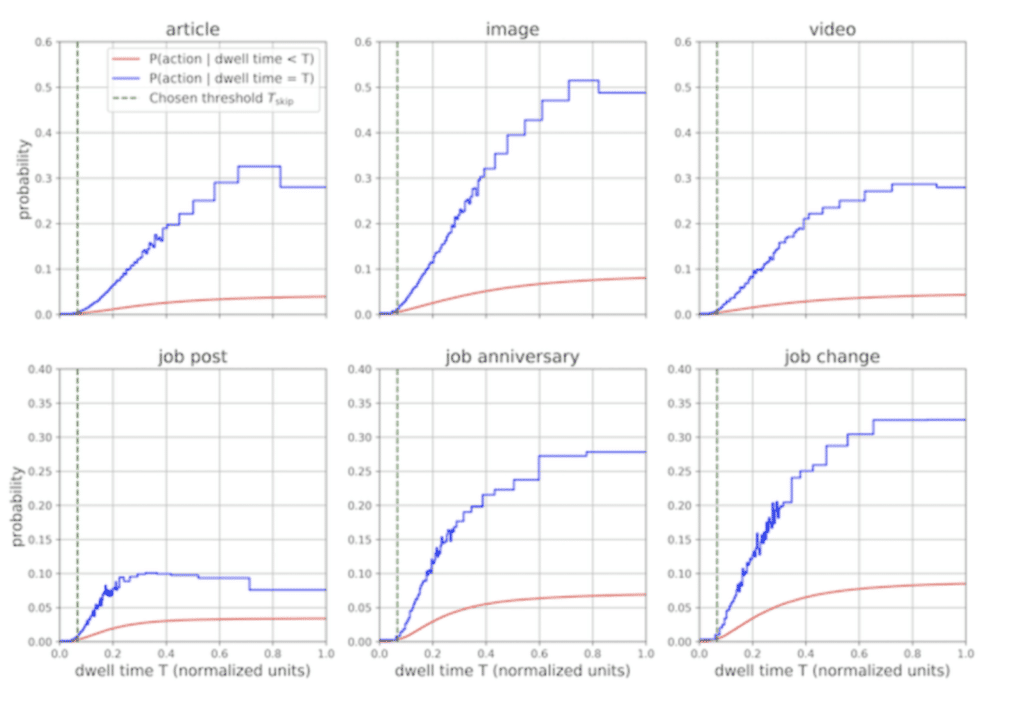
LinkedIn’s Next Focus: Messaging
Messaging has been an integral part of the LinkedIn ecosystem since its creation in 2002, yet has architecturally remained unchanged until recently.
When looking at the messaging redesign, the LinkedIn engineers made requirements can be summed into two categories: Product requirements and Engineering Requirements.
Product
On the product side, great things are coming for LinkedIn Messaging. This includes a faster user experience and possible third-party plug-ins that can enhance your experience and easier to use.
Let’s be honest. We all know the pain of trying to filter through the current messaging inbox – these updates will be a welcome change.
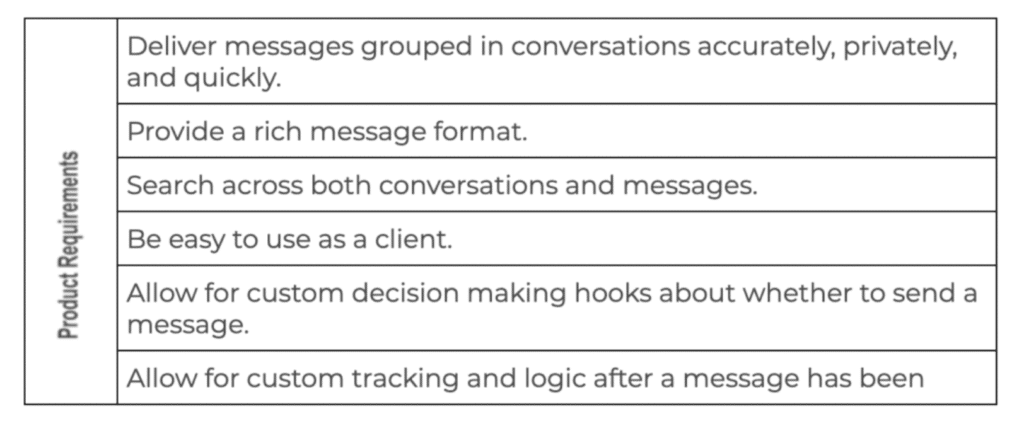
Engineering
Architecturally speaking, there is an increased focus on security, uptime and availability to change architecture very quickly. That means that the engineering team will be able to keep up with the rapidly changing times, be able to detect spam quickly and adjust on a dime.
At the end of the day, LinkedIn’s Engineering team has a high focus on LinkedIn Professional Community Policies – and every change they make ensures enhanced respect for these policies.
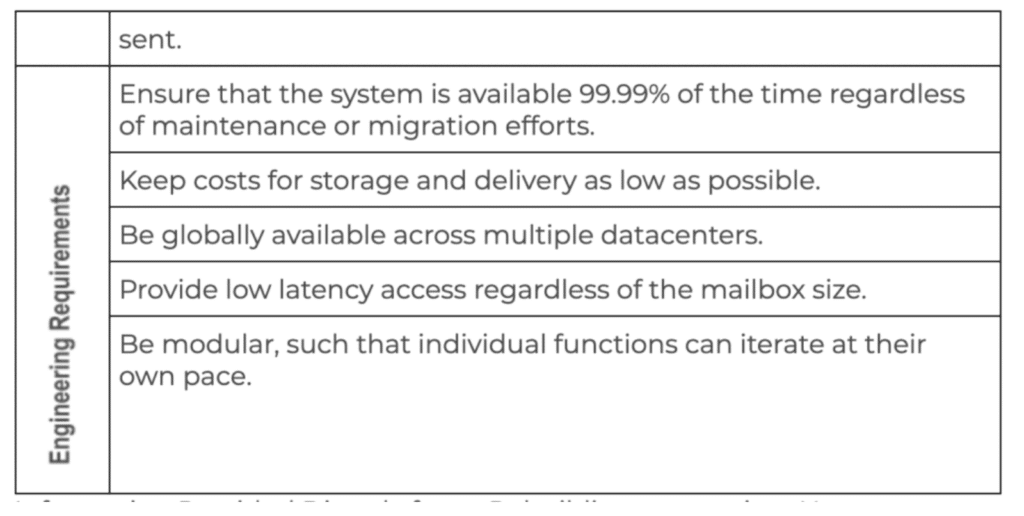
Want to Win at Growing Your Business on LinkedIn?
LinkedIn is the most powerful platform B2B brands can use to build pipeline.
And we’re not just saying it.
At RevenueZen, LinkedIn is one of our primary acquisition channels, so we definitely know what we’re talking about.
With years of studying the platform, we’ve developed a system that has helped many clients leverage LinkedIn successfully.
We love (and have perfected the art of) creating LinkedIn-friendly content that withstands even the craziest of algorithm changes. So if you need help becoming a thought leader in your space, get in touch for our LinkedIn marketing services today.

